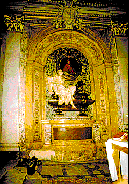 Map of the Cathedral of San Paull |
The Cathedral Church of San Paul was erect on the ancient chapel Sanctu Paulum at Averse and it is situated on the oriental side of the opposite square, in the shape of a funnel, an area of its ancient cemetery and ombelicus of the ancient center. In the architrave of the northern portal of the church the writing indicates the time of the building of the large transept and the domes: +Princeps Jordan(us) Richardo Principe natus.. One more writing is located in the principal door: Vultu iucundo Roberto dante secundo |
|
|
The
church, initiated by Rainulf in 1031, and completed by
Robert II in 1127, larger than the Cathedral of Naples and
Capua, has undergone re-arrangements and metamorphoses that
have altered irreparably the original appearance: part of
the segmented dome cladding of the central dome, with the
two orders of false arcade, was rebuilt in the XIII sec.;
one of the four helicoidal woodworks, that of the right
entry pillar; the bell tower, adjacent to the central dome,
collapsed, was rebuilt on the right of the façade on
an other bell tower in the XV sec. |
|
It
is an authentic masterpiece known to have been a model for
more releases, also of the same artist; the beautiful
painting of the Adorazione
of the Magi
by Cornelis
Smet follows, unusual interesting composition for the
variety of the colouristic contrasts. In the
Chapel
of the Chapter are,
on the walls, the fresco of the
Cacciata
dal Tempio by Eliodoro,
a copy from Raffaello, on the vault,
theStorie
of the Virgin and prophets,
by Francesco Antonio Altobello from Bitonto and, on the
altar, a painting of the Madonna
con il Bambino, the Saints Pietro and Paolo and bishop
Carafa,a possible
painting by Michael Regolia (XVII sec.), that reproduces a
sight of Aversa with the Cathedral and the new bell tower
with the pinnacle in the background. |
 Deambulatorio (c. 1031-32) |
|
 Stipite, Knight with dragon (c.1030) |
In
theChapel
of the Relics
(1637) frescos of the seventeenth century, scrolls and
inscriptions are: in the vault Gloria
of the Faith, in
the lunette God
Father and musician angels,
while, on the wall on the bottom, the
Madonna
col Bambino and a
ligneous statue of San
Paolo of XVII sec.
In the varied partitions of the walls, besides the numerous
Relics,
in 207 shrines, among which a thorn of the
crown
of Christ hat
blooms when the holy Friday falls on March 25th, feast of
the Annunziata, the silvery busts
of San Sebastiano,
St.
Joseph with the Child
of the seventeenth century and San
Paul, di San Francesco of Assisi
and
Sant'Antonio
of Padova, of the
eighteenth century are deposed; all named Small Patrons of
the city in 1693. |
|||
|
The
walls of the ambulatory
in origin were frescos, like some painted pieces still in
situ demonstrate; theMadonna
on the throne with the Child
of the first left span (second half of XV sec.). |
 |
|
 |
 |
 |
|
|
|
|
|
|
|
|
|
|
|